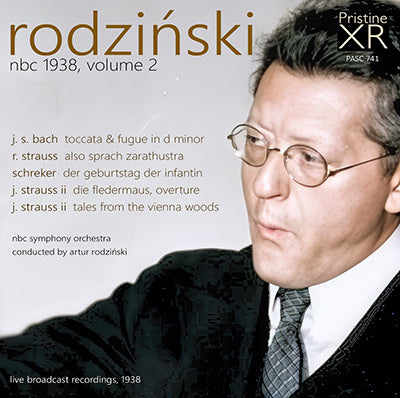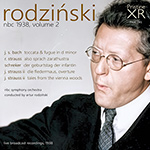
This album is included in the following sets:
This set contains the following albums:
- Producer's Note
- Full Track Listing
- Cover Art
The performance was one of exceptional brilliancy and one that displayed to very marked advantage the virtuosity of the orchestra. Aside from its interpretive merits, it may be said that a presentation of this music which displays so much certainty and such high technical quality is rare. Add to this the authority and the fire of the reading.
“Zarathustra” is anything but a simple score to interpret. The conductor’s handicap from the aspect of concert effect is the faint and enigmatical conclusion. This can so easily become anti-climax, to say nothing of the mystifying effect of the strange harmonic scheme. But the audience responded last night to a work which formerly baffled the public with unstinted enthusiasm.
And this is noteworthy: the music triumphed in the complete absence of any programmatic explanation. Explanatory paragraphs would have been wholly in order. Strauss himself affixed lines from Nietzsche's poem to his score. The audience deserves a program note when this work is played.
This does not lessen the music, but it can greatly conduce to a listener’s appreciation of the composer’s intention, if he knows, for example, that the magnificent introduction, which made Philip Hale think of “the portals of eternity swinging slowly asunder,” is Strauss’s evocation of the sunrise; that the pathetic and mystical passages immediately following, and the great hymn passionately intoned by organ and orchestra, is reference to religion upon which man pinned his faith; that the climax of frantic rejoicing while the great bell tolls in the orchestra is the song of Nietzsche’s victorious Over-man; and that the ending, in two keys, with the theme of Nature heard in the plucked basses, and the theme of the Ideal, like receding stars, soaring aloft, is Strauss’s comment upon the unsolvable riddle of the universe.
But the music made its mark and greatly moved the audience. It would have been still more imposing for those personally present if the performance had taken place in an auditorium with better acoustics than those of Studio H-8, which deadens sound and lessens the sonority of an orchestra. The effect of breadth as well as sheer body and brilliancy of sound in this place is thus modified, and blazing sonorities are part of the very conception of this score. But the effect was on the whole so adequate and eloquent that it would be captious to fuss over details. “Zarathustra” has waited longest of all Strauss’s tone-poems to come into its own. The sum of this occasion was a performances which carried it convincingly and in a very exciting way to the public.
The concert opened with the excellent Wertheim’s version of the Bach D minor Toccata and Fugue, a sonorous and effective performance of a masterpiece of universal meaning. After Strauss came the charming concert suite that Schrecker arranged from his ballet, “The Birthday of the Infanta.” It is not wildly modern music, nor highly original, but it is pleasing and admirably orchestrated material, put together with skill and taste by an expert craftsman.
Other delightful music, more original than Schrecker’s, and destined to live much longer, completed the program and delighted the audience. The reference is to the overture to “Fledermaus” and the waltz “Tales From the Vienna Woods,” by Johann Strauss. He also could write music.
Olin Downes, The New York Times, 17 April 1938
RODZINSKI NBC 1938, Volume 2
1. RADIO Introduction (1:25)
J. S. BACH (arr. Wertheim) Toccata and Fugue in D minor, BWV 565
2. Toccata (2:57)
3. Fugue (6:05)
R. STRAUSS Also Sprach Zarathustra, Op. 30
4. Einleitung (2:10)
5. Von den Hinterweltlern (3:38)
6. Von der grossen Sehnsucht (1:58)
7. Von den Freuden-und Leidenschaften (1:56)
8. Das Grablied (2:12)
9. Von der Wissenschaft (4:34)
10. Der Genesende (5:38)
11. Das Tanzlied (5:46)
12. Nachtwandlerlied (6:52)
SCHREKER Der Geburtstag der Infantin - Suite
13. 1. Reigen (1:47)
14. 2. Aufzug und kampfspiel (2:11)
15. 3. Die Marionetten (2:49)
16. 4. Minuett der Tanzerknaken (2:11)
17. 5. Die Tanze der Zwerges (0:15)
18. 6. Mit der Wind im Fruhling (0:53)
19. 7. In blauen Sandalen uber das korn (1:52)
20. 8. Im roten Gewand im herbst (1:23)
21. 9. Die Rose der Infatin (3:41)
22. J STRAUSS II Die Fledermaus - Overture (8:14)
23. J STRAUSS II Tales from the Vienna Woods (7:05)
NBC Symphony Orchestra
conducted by Artur Rodziński
XR remastering by: Andrew Rose
Live broadcast recording, 16 April 1938, Studio 8H, NBC Radio City, New York
Cover artwork based on a photograph of Artur Rodziński
Total duration: 77:31

